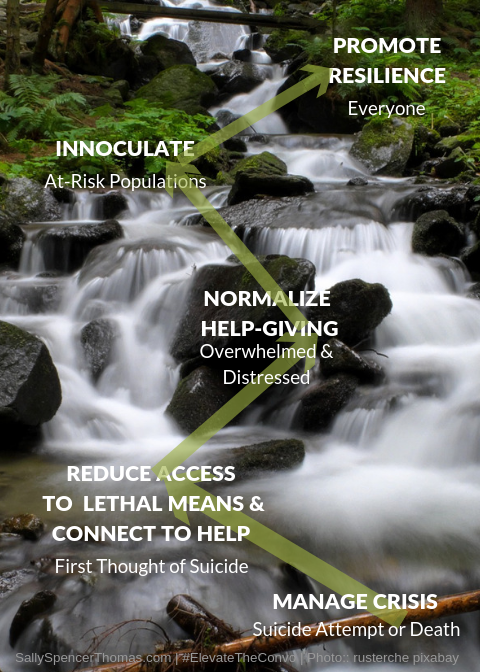A Comprehensive Approach — The Stream Parable
What the research tells us is that our best outcomes in reducing suicide rates come from comprehensive and sustained efforts where training is just one component of an overall strategy (Knox, et al, 2003). The following common parable from the public health perspective illuminates what a comprehensive approach might entail. “Upstream, midstream and downstream” approaches are needed to prevent suicide.
Upstream strategies build protective factors that can mitigate risk, such as creating a sense of belonging, eliminating stigmatized language and discriminating actions, building resilience through life skills and mental hardiness, and enhancing mental health literacy.
Midstream approaches help identify people in emerging risk and then link them to appropriate support before the issues develop into a suicidal crisis. Midstream strategies include screening for mental health conditions and suicidal thoughts, promoting and normalizing many types of help-seeking/help-giving behavior, and training populations on how to have difficult suicide-specific conversations.
Вывод из запоя в клинике доктора Шурова
Downstream tactics are needed to guide the response when a suicide crisis has happened including when people have acute thoughts of suicide, attempt suicide or die by suicide. Current thinking about effective downstream tactics is that they are not so much about constraint (e.g., involuntary hospitalization, restraints, and isolation) but rather focus on an attempt to answer the question, “How can we approach these crises in a way that offers connection, dignity and empowerment instead of fear?
Stream Parable

You are walking along a river one day and you hear a plea for help from someone drowning. You are startled but energized as you dive into the water and save him. Using all your strength you pull him to shore and start administering CPR. Your adrenaline is racing as he starts to regain consciousness. Just as you are about get back on your feet, another frantic call comes from the river. You can’t believe it! You dive back in the river and pull out a woman who also needs life-saving care. Now a bit frazzled but still thrilled that you have saved two lives in one day, you mop the sweat from your brow. When you turn around, however, you see more drowning people coming down the river. One after another.
You shout out to all the other people around you to help. Now there are several people in the river with you – pulling drowning people out left and right. One of the rescuers swims out to the drowning group and tries to start teaching them how to tread water. This strategy helps some, but not all because it turns out it’s hard to learn how to tread water when you are drowning.
Everyone looks at each other, completely overwhelmed, wondering when this will stop. Finally, you stand up and start running upstream. Another rescuer glares at you and shouts, “Where are you going? There are so many drowning people; we need everyone here to help!” To which you reply, “I’m going upstream to find out why who is pushing all of these people into the river.”

